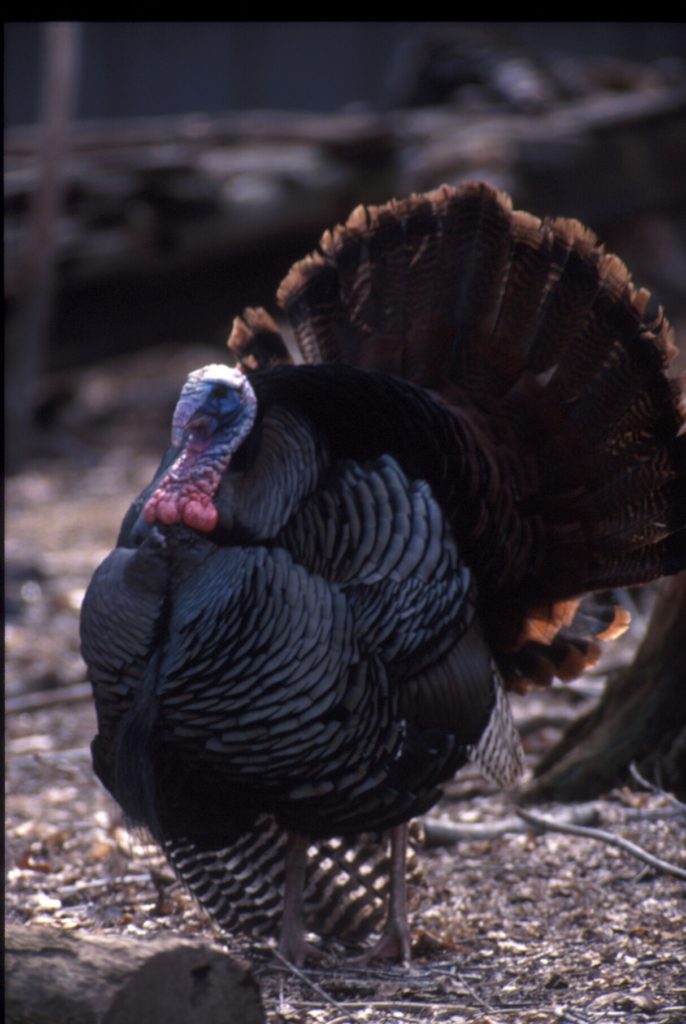The Wild Turkey: Conservation Success Story

The wild turkey has made a successful comeback in Ohio. Photo from Ohio Department of Natural Resources.
In the Open

The past few mornings as I have walked out my back door into the pre-dawn twilight, I have been greeted by the booming echo of male wild turkeys, gobbling loudly, competing for mates.
It occurred to me that my grandparents, when they were my age, although they would have definitely recognized the sound of turkeys gobbling, would not have dreamed that they were hearing wild turkeys. Fifty years ago, the only wild turkey to be found in our neck of the woods was on the liquor store shelf.
The Eastern Wild Turkey, Meleagris Gallopavo, was very familiar to the indigenous people of the Ohio Country, and to the settlers who followed. They were found throughout the entire state, but unregulated subsistence hunting and destruction of the old-growth forests took such a toll on the birds that they were considered completely extirpated by 1904, according to the Ohio Department of Natural Resources’ Division of Wildlife.
If you enjoy watching these large birds, consider thanking a sportsman. Conservation groups like the National Wild Turkey Federation and individuals, primarily through the purchase of hunting licenses and tags, directly funded the reintroduction of the wild turkey into Ohio in the 1950s. The first time I saw one in the wild was in the late 1980s, and from there the population literally exploded.
According to the Ohio Division of Wildlife, Ohio’s first modern turkey season was in 1966 in nine counties, and hunters reported killing 12 birds. The harvest exceeded 1,000 birds for the first time in 1984, and in 2000 the season opened statewide for the first time with hunters tagging more than 20,000 birds. Last year hunters harvested more than 17,000 gobblers during the spring season.
The 2016 Ohio spring hunting season opens on Monday, April 18, and the youth wild turkey season is Saturday and Sunday, April 16-17. The Ohio Division of Wildlife anticipates approximately 65,000 licensed hunters, not counting exempt landowners hunting on their own property, will enjoy Ohio’s popular spring wild turkey season before it ends on Sunday, May 15.
Hunters are required to have a hunting license and a spring turkey hunting permit. The spring season bag limit is two bearded turkeys. Hunters can harvest one bearded turkey per day, and a second spring turkey permit can be purchased at any time throughout the spring turkey season. Turkeys must be checked no later than 11:30 p.m. the day of harvest.
All hunters must report their turkey harvest using the automated game-check system. Game-check is available online, by phone or at a license agent. A complete list of participating license agents can be found at wildohio.gov. Visit the Turkey Hunting Resources page at wildohio.gov, or call 800-WILDLIFE (945-3543) for more information about the game-check process.
Ohio hunting hours are 30 minutes before sunrise until noon from April 18-May 1. Hunting hours from May 2-15 will be 30 minutes before sunrise to sunset. Hunting hours are 30 minutes before sunrise to sunset during the two-day youth season.
Hunters may use shotguns or archery equipment to hunt wild turkeys. It is unlawful to hunt turkeys using bait, live decoys or electronic calling devices or to shoot a wild turkey while it is in a tree. The ODNR Division of Wildlife advises turkey hunters wear hunter orange clothing when entering, leaving or moving through hunting areas in order to remain visible to others.
Check with ODNR-DOW for more specific details or questions, and always practice safe hunting and sportsmanship. Wild turkey hunting carries one particular safety concern in that hunters are actually pretending to be another bird in an effort to lure in a legal gobbler. As always, remember the primary rules of safe gun handling: control the direction of your muzzle, treat every gun with the respect due a loaded gun, know your target and what is beyond it, and keep your finger off the trigger until you are ready to shoot.
Jim Freeman is the wildlife specialist for the Meigs Soil and Water Conservation District, and his column generally appears every other week. He can be contacted weekdays at 740-992-4282 or at [email protected]






